In the ever-evolving landscape of blockchain technology, decentralized applications, or DApp, have emerged as a revolutionary force, reshaping the way we interact with the digital world. This comprehensive article delves deeply into the world of DApp, providing an extensive exploration of their history, functionality, key features, types, use cases, as well as their pros and cons.
What is DApp?
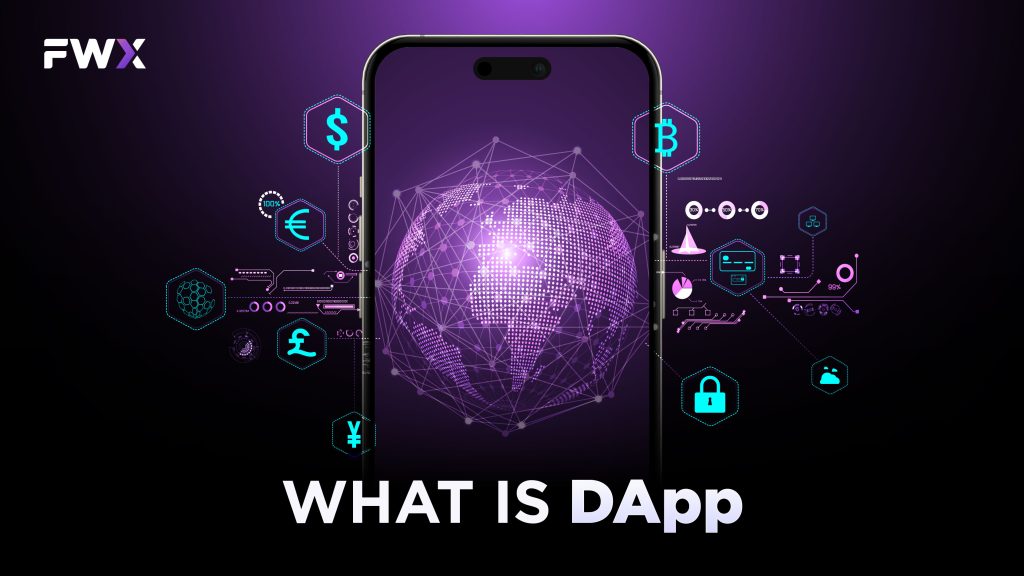
DApps have a relatively short but impactful history. The concept of decentralized applications was introduced in 2013 by Daniel Larimer, the creator of BitShares. However, it was Ethereum, launched in 2015, that truly popularized DApps. Ethereum’s smart contract capabilities allow developers to create decentralized applications, and this led to a proliferation of DApps across various industries. Over time, the DApp ecosystem has continued to grow, and DApps are now a significant component of the blockchain landscape.
DApp (Decentralized application) is a software application that operates on a blockchain network. Unlike traditional, centralized applications, DApps are open-source, trustless, and operate autonomously without a single central authority. They use blockchain technology to ensure transparency, security, and immutability. This unique architecture distinguishes them from traditional applications, making them highly resilient and robust.
Centralized Application vs. Decentralized Application
Centralized applications rely on a central authority or intermediary for their operation. This centralization can lead to issues such as data breaches, censorship, and a single point of failure. In contrast, DApps operate on a decentralized network, reducing the risk of these issues and providing more control and ownership to users. The elimination of intermediaries and central points of control is a fundamental paradigm shift that decentralization brings.
How Does a DApp Work? and Key Features
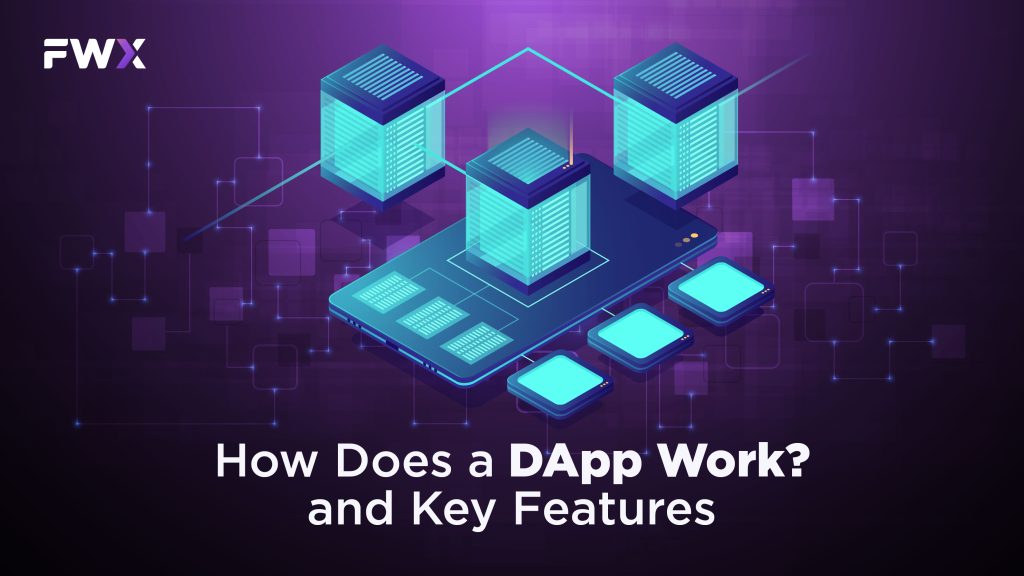
DApps utilize blockchain technology to function. They consist of three main components: a blockchain as a backend, a smart contract for business logic, and a frontend user interface. The blockchain stores data and transactions, while smart contracts execute predefined rules and logic. Users interact with the DApp through the frontend, which can be a web interface or a mobile application. This architectural framework ensures transparency, security, and immutability while offering users a familiar interface.
Key features of DApps include:
- Open Source: DApps are typically open-source, making their code accessible and transparent to anyone. This transparency promotes trust and collaboration within the DApp community.
- Decentralization: They operate on a decentralized network, reducing the risk of censorship and single points of failure. This decentralized nature ensures that DApps can continue to function even if certain network nodes go offline.
- Trustlessness: DApps eliminate the need for intermediaries, allowing users to transact directly with confidence. This trustless environment minimizes the potential for fraud and corruption.
- Security: Blockchain technology ensures the security and immutability of data and transactions. DApp users can trust that their data and assets are well-protected from unauthorized access.
- Immutability: Once data is recorded on the blockchain, it cannot be altered or deleted, ensuring the integrity of the application’s historical records.
Types of DApps
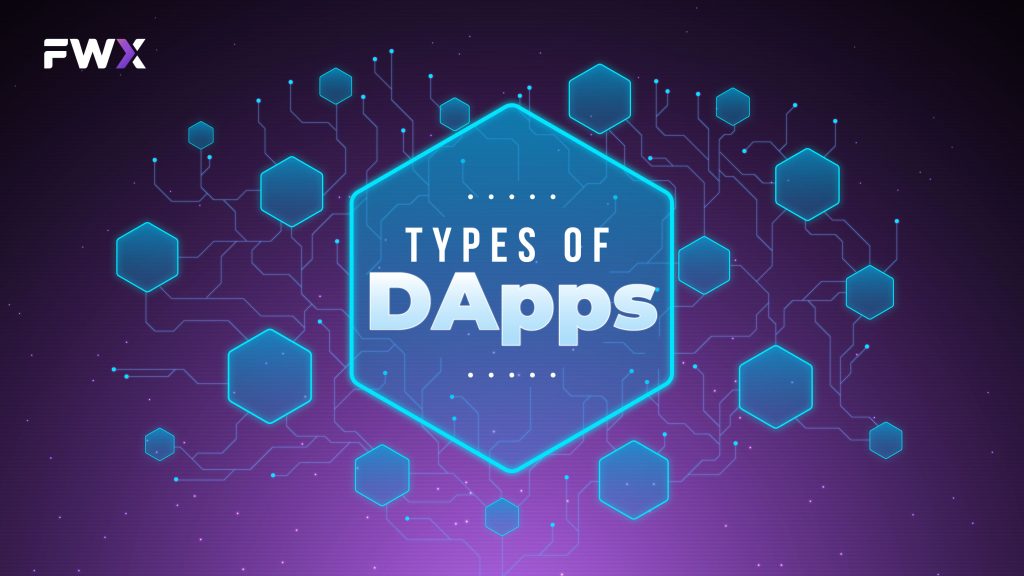
DApps are categorized into three main types:
- Type I: These are blockchain-based applications with their own native cryptocurrencies (e.g., Bitcoin, Ethereum). They have their own blockchain and token that powers the DApp’s ecosystem.
- Type II: These apps use blockchain technology but rely on Type I DApps for security and consensus (e.g., Sia, which relies on the Ethereum blockchain). Type II DApps leverage existing blockchain infrastructure and tokens to enhance their functionality.
- Type III: These are decentralized apps that don’t have their own blockchain or cryptocurrency (e.g., CryptoKitties, which uses Ethereum’s blockchain). Type III DApps often leverage existing blockchain networks to operate, making them highly accessible to a broad user base.
DApp Use Cases
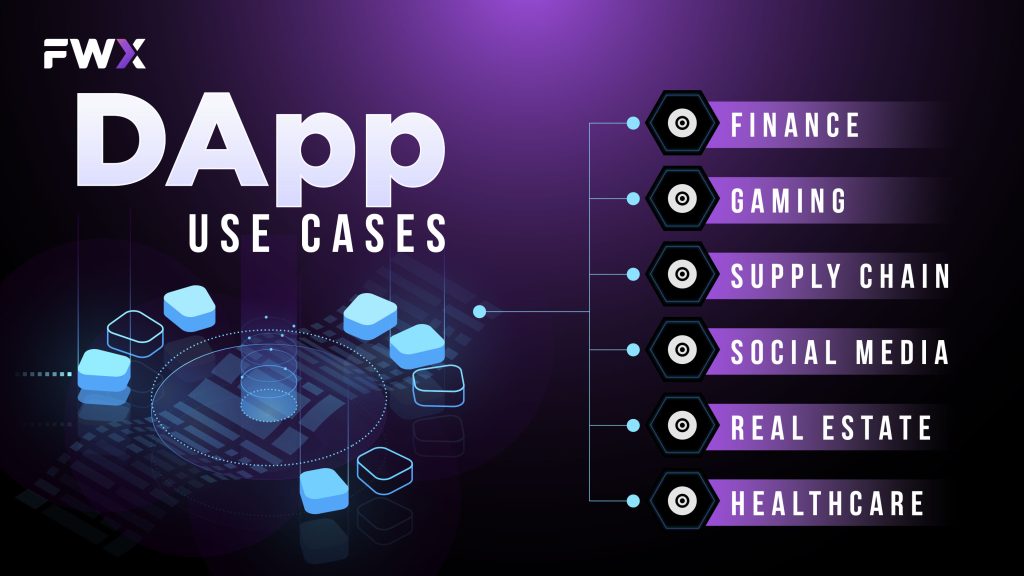
DApps find applications in various sectors, transforming the way we engage with digital systems:
- Finance: DApps facilitate peer-to-peer lending, decentralized exchanges, and automated financial services. They offer innovative solutions for remittances and cross-border transactions, enabling greater financial inclusion.
- Gaming: They enable blockchain-based gaming, tokenized assets, and non-fungible tokens (NFTs). DApps have opened new possibilities for gamers to own and trade in-game assets securely.
- Supply Chain: DApp improves transparency in supply chain management, reducing fraud and ensuring authenticity. The ability to trace products from source to destination enhances accountability and quality control.
- Social Media: Some DApps offer decentralized social platforms, giving users control over their data and the ability to monetize their content directly. This counters the prevalent issues of data exploitation and censorship in centralized social media.
- Real Estate: DApp is being used to streamline property transactions and record-keeping. This reduces the complexity and cost of real estate deals while increasing transparency.
- Healthcare: They enhance the security and accessibility of patient records and pharmaceutical supply chains. DApps in healthcare ensure that sensitive data is kept confidential and can be securely shared among authorized parties.
Pros and Cons of DApps
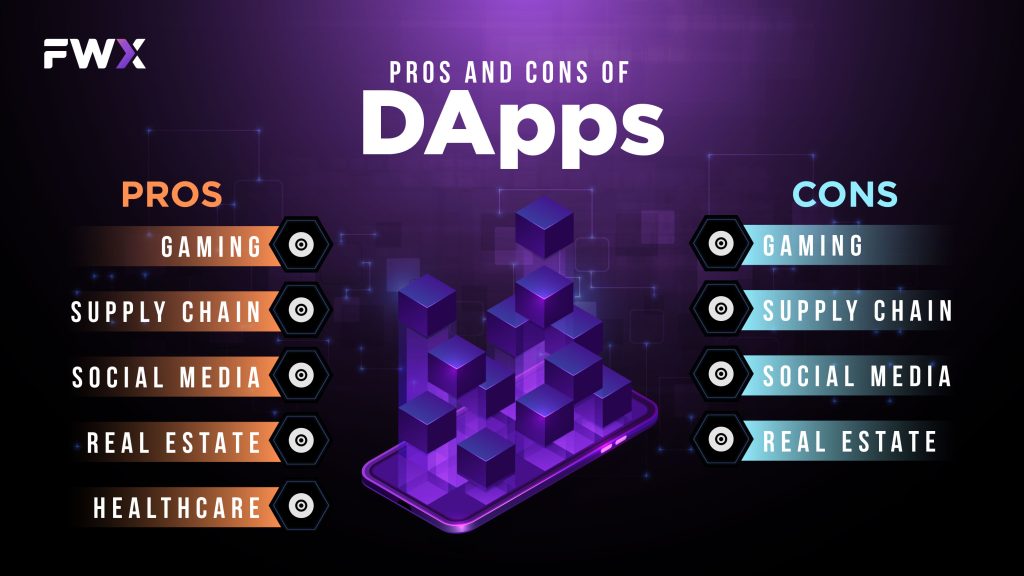
The advantages of DApps are manifold and include:
- Security: DApps are highly resistant to hacking and data breaches due to blockchain technology. The decentralized architecture minimizes the risk of a single point of failure, and the immutability of the blockchain ensures data integrity.
- Transparency: The blockchain ledger ensures transparent and immutable data records. Users can verify transactions and data at any time, promoting trust within the ecosystem.
- Ownership: Users have greater control over their data and digital assets. Unlike centralized applications, which often retain ownership of user data, DApp empowers users to manage their information and assets as they see fit.
- Reduced Intermediaries: DApps cut out intermediaries., reducing transaction costs. This financial benefit is especially significant in financial applications where fees can significantly impact users’ returns.
- Global Accessibility: DApp can be accessed from anywhere, making them borderless. This is particularly advantageous for users in regions with limited access to traditional financial and digital services.
While DApps offer numerous advantages, they also face certain challenges, including:
- Scalability: Some DApps struggle with scalability issues, causing slower transaction times. As the user base grows, the blockchain networks supporting DApps must find efficient solutions to handle increased demand.
- User Experience: DApps can be less user-friendly compared to traditional apps. This is partly due to the complexity of blockchain technology and the need for users to manage their private keys. User interfaces and experiences are areas that require improvement.
- Regulatory Challenges: They can face regulatory hurdles due to their decentralized nature. Governments and regulatory bodies are still adapting to the rise of DApps, and legal frameworks remain a work in progress.
- Energy Consumption: Some DApps, particularly those using Proof of Work blockchains, consume significant energy. This environmental impact has prompted discussions about transitioning to more energy-efficient consensus mechanisms.
Conclusion
In conclusion, decentralized applications, or DApps, represent a significant shift in how we interact with digital technology. With their transparent, secure, and decentralized nature, DApps are poised to revolutionize various industries, reshaping the way we conduct financial transactions, play games, manage supply chains, and communicate. However, they are not without their challenges, and their widespread adoption depends on addressing scalability issues, improving user experience, and navigating the evolving regulatory landscape. As blockchain technology continues to evolve, DApps are likely to play a significant role in the future of the digital world, bringing about a more decentralized and secure digital ecosystem that empowers users, fosters trust, and expands access to digital services on a global scale. The potential of DApps are extensive, and their impact on our digital future is bound to be profound. As the technology continues to evolve, we can expect to see more innovative use cases and an even more user-friendly experience, making DApps an integral part of our digital lives.


